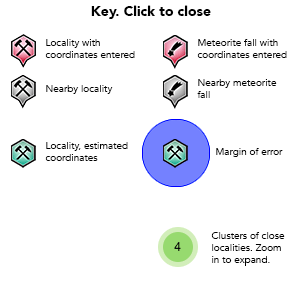Sir William Don Mine, Newington, City of Ballarat, Victoria, Australia

| Latitude & Longitude (WGS84): | 37° 33' 44'' South , 143° 50' 26'' East |
|---|---|
| Latitude & Longitude (decimal): | -37.56231,143.84068 |
| GeoHash: | G#: r1q631vxd |
| Köppen climate type: | Cfb : Temperate oceanic climate |
Historic gold mine.
The mine had a brief but spectacular history, achieving 76 830 ounces of gold, the ninth highest alluvial gold figure for a mine on the Ballarat goldfield. Gold production only occurred from 1865 to 1868.
The mine is possibly named after a 19th Century British actor, who died in Hobart while touring Australia. The company was formed in 1861 as a spin off from the Hand in Hand Company. A shaft from this company was ceded, and the company also had rights to mine under the cricket ground to the south.
Many denounced the company in its early days as a swindle with shares being virtually given away to prevent calls. The shaft was deepened hitting wash dirt 64 metres below the surface, at 150 metres wide as a number of terraces. November 1865 produced 414 ounces, and 100 ounces per week shortly after, increasing to 450 to 943 ounces per week early 1866. August of that year saw 8396 ounces produced. In 1867, January 3261 ounces, February 2413 ounces, March 2910 ounces, April 4974 ounces, May/June around 2000 ounces, July 2601 ounces, August 1839 ounces, September 3000 ounces, October 1700 ounces, November 1577 ounces, and December around 650 ounces.
The shaft was then closed for repairs, and a battery erected to process auriferous cement found in October. The cemented wash was 60 metres north of the cricket ground at 15 metres wide. It proved poor. The mine closed in 1868.
By 1867, it became apparent to neighbouring mining companies the Sir William Don was on rich ground, and a complex set of law cases ensued between the Sir William Don Company and the New Cosmopolitan, Kohinoor, Warrior, Privateer, Newington, Great Redan Extended, and Band of Hope companies. This resulted in a Royal Commission who decided on what land would go to what company. Joseph Simkin was mine manager.
The site of the shaft borders the south side of Dana Street, just west of Ripon Street.
Select Mineral List Type
Standard Detailed Strunz Dana Chemical ElementsDetailed Mineral List:
| ⓘ Gold Formula: Au Reference: Centenary Gold Monument, Albert and Sturt streets, Ballarat. |
List of minerals arranged by Dana 8th Edition classification
| Group 1 - NATIVE ELEMENTS AND ALLOYS | |||
|---|---|---|---|
| Metals, other than the Platinum Group | |||
| ⓘ | Gold | 1.1.1.1 | Au |
Regional Geology
This geological map and associated information on rock units at or nearby to the coordinates given for this locality is based on relatively small scale geological maps provided by various national Geological Surveys. This does not necessarily represent the complete geology at this locality but it gives a background for the region in which it is found.
Click on geological units on the map for more information. Click here to view full-screen map on Macrostrat.org
| Holocene - Miocene 0 - 23.03 Ma ID: 704630 | Newer Volcanic Group Age: Cenozoic (0 - 23.03 Ma) Stratigraphic Name: Newer Volcanic Group Description: Cinder cones - scoria, minor ash and agglutinates; Lava flows - tholeiitic to minor alkaline and basanitic lavas. Comments: igneous mafic volcanic; synthesis of multiple published descriptions Lithology: Igneous mafic volcanic Reference: Raymond, O.L., Liu, S., Gallagher, R., Zhang, W., Highet, L.M. Surface Geology of Australia 1:1 million scale dataset 2012 edition. Commonwealth of Australia (Geoscience Australia). [5] |
| Early Silurian - Cambrian 427.4 - 541 Ma ID: 3185333 | Paleozoic sedimentary rocks Age: Paleozoic (427.4 - 541 Ma) Comments: Lachlan Fold Belt Lithology: Sedimentary rocks Reference: Chorlton, L.B. Generalized geology of the world: bedrock domains and major faults in GIS format: a small-scale world geology map with an extended geological attribute database. doi: 10.4095/223767. Geological Survey of Canada, Open File 5529. [154] |
Data and map coding provided by Macrostrat.org, used under Creative Commons Attribution 4.0 License



